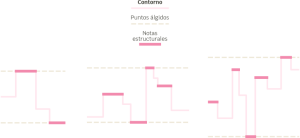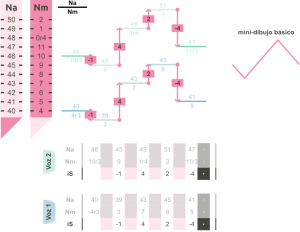Sound design
A sound voice is formed by a succession of sounds, which can be developed in many different ways. To begin exploring the development of sound succesions, we will focus on iS selection, melodic contour and sound cell ornamentation.
When selecting the iS of our sequences we have to take into account their direction: ascending (no sign) or descending (- sign).
To choose the iS of our successions, we propose 3 «levels of freedom»:
- selection of the same predominant iS throughout the succesion.
- predefined logical sequence of various iS, which form a structure.
- free selection of varied iS, which form a random structure.

In the same way that for the comprehension of a speech, continuity and fluidity are necessary, for the comprehension of a melody we also seek to give it continuity and fluidity, which is an art.
The melodic contour is the profile of the movement of our sound succesion, and is represented by a graph:

This graph gives us a valuable insight into the directionality, continuity and fluidity of our succession, key to achieving our goal: understanding. In the graph we can observe:
- Structural notes: these are the main notes that define the most basic drawing of our sequence.
- the high points: these are the points that form a «peak» in our drawing. They correspond to the highest and lowest structural notes of our succesion, and define a directionality of the musical discourse.
- the basic drawing: it is the «skeleton» of the melodic contour, formed by the high points and the initial and final Note of our succession. The following are different proposals:

Sound cells are short successions of at least 2 iS, which link and embellish the space between 2 structural notes of our melody (flourishes, groupings, passing notes…). We classify them according to the number of iS: cells with 2 iS, those with 3, those with 4, 5, 6…
Just as the outline of a melody follows a basic drawing, the sound cells also follow a basic mini-drawing:

Once we have assimilated the different types of iS selection, the melodic contour and the sound cells, we can now approach the sound design process. To begin to explore this process, we propose 2 different approaches, taking into account the following sound parameters:
- make our sound design by paying attention to what type of iS we select, and observe how an outline appears. Finally we can extract some parameters.
- define in advance a contour with some parameters, and fill it with N and iS.
Good luck, enjoy!

